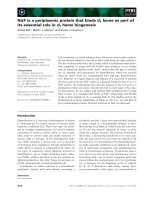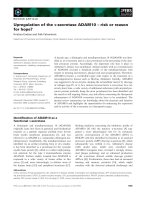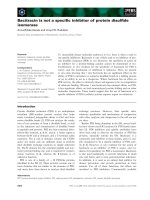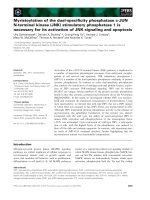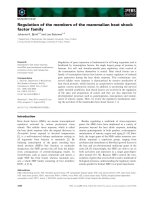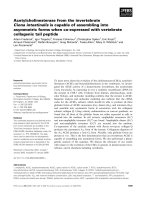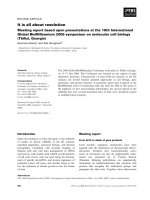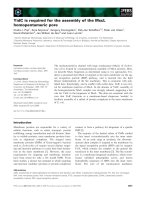Báo cáo khoa học: "WHEN IS THE NEXT ALPAC REPORT DUE" ppt
Bạn đang xem bản rút gọn của tài liệu. Xem và tải ngay bản đầy đủ của tài liệu tại đây (137.64 KB, 2 trang )
WHEN IS THE NEXT ALPAC REPORT DUE ?
Margaret KING
Dalle MolIe Institute for Semantic and Cognitive Studies
University of Geneva
Switzerland
~.~chine translation has a scme%~at checquered
history. There were already proposals for autcmatic
translation systems in the 30's, but it was not
until after the second world war that real enthu-
siasm led to heavy funding and unrealistic expec-
tations. Traditionally, the start of intensive
work on machine translation is taken as being a
memorand~n of Warren Weaver, then Director of the
Natural Sciences Division of the Rockefeller
Foundation, in 1949. In this memorandL~n, called
'Translation', Weaver took stock of earlier work
done by Booth and Richens. He likened the problem
of machine translation to the problem of code
breaking, for which digital cc~uters had been
used with considerable success : "It is very
tempting to say that a book written in Chinese
is silly a book written in English which was
coded into the 'Chinese code'. If we have useful
methods for solving almost any cryptographic pro-
blem, may it not be that with proper interpreta-
tion we already have useful methods for transla-
tion?" (Weaver, 1949).
Weaver's m~rorand~ led to a great deal of
activity in resoarch on machine translation, and
eventually to the first conference on the topic,
organised by Bar-Hillel in 1952. At this confe-
rence, optimism reigned. Afterwards, tea~s in a
number of American universities pursued research
along the general lines agreed at the conference
to be fruitful. At Georgetown University, L.E.
Dostert started up a machine translation project
with the declared aim of building a pilot system
to convince potential funding agencies of the
feasibility and the practicability of machine
translation. This led in 1954 to the famous
Georgetown experiment, a pilot system translating
from Russian to English, which was hailed as an
unqualified success: during the next ten years
over 20 million dollars were invested in machine
translation by various US government agencies.
An idea of the anount of resoarch between
1956 and 1959 can be gained by considering that in
those years no fewer than twelve research groups
were established in the US, a number of groups
in the USSR ca~e into existence, most within the
Academy of Sciences in Moscow, and two British
Universities were carrying on research.
Most of the systems developed were based on
what Buchmann (1984) has called a 'brute force'
approach: Syntactic analysis was only done at
a local word-centred level, both so-called syntax
and dictionary cc~pilation ~ere very narrowly
corpus based, and thus almost totally empirical.
Indeed, the problem of machine translation was
perceived as being an engineering problem requir-
ing clever programming rather than linguistic
insight.
By_ the late 1960"s, workers in mchine trans-
lation themselves had begun to see that the enpi-
rical approach was unsatisfactory. The European
projects begun in the early 1960's at Grenoble
and Milan reflect this, as does the work of the
group sot up in Montreal in 1962. These groups
based their work from the start on clear theore-
tical foundations (dependency theory in Grenoble,
correlational grammar in Milan, transformational
theory in Montreal).
However, the growing perception that brute
force was not enough came too late to save re-
search in the US. In 1964, the US National Academy
of Sciences set up an investigatory committee,
the Autcmatic Language Processing Advisory C~n-
mlttee (ALPAC), with the task of investigating
the results so far obtained and advising on fur-
ther funding. The committee, in setting up a fra~e-
work for assessing machine translation, considered
such questions as quality and effectiveness of
h~an translation, t_he time and money required
for scientists to learn Russian, amounts spent
for translation within the US goverrfaent and the
need for translations and translators. Based on
such criteria, the committee care to a strong
negative conclusion ' we do not have useful
machine translation. Further, there is no imme-
diate or predictable prospect of useful machine
translation '.
The ALPAC report effectively killed machine
translation research in the States, although some
European projects survived.
In the years since the ALPAC report, a number
of commercial systems has been developed, some of
them, ironically, based on the very system so
roundly condemned by the ALPAC conndttee. Two
trends can he distinguished: systems, such as
SYSTRAN, which still aim at no significant human
intervention during the translation process, but
accept pre- and/or post-editing, and interactive
systems which aim primarily at being translators'
aids, such as Weidner or Alps.
352
In recent years, partially because the deve-
lopment of commercial systems renewed faith in the
feasibility of mad%ine translation, partially
because of the results achievt~ by the surviving
res~ar~ h projects, above all because of the grow-
ing and pressing need for tramslation, research in
machine translation has begun to revive. At the
recreant, the European Ccnmunity is sponsoring a
large research and development programme, France
has a National Project on machine translation, a
very large ntm~r of projects are being funded in
Japan and a German Corporation is proposing
mercial development of a system developed at the
University of Texas.
There are people who see strong parallels
between the present situation and that ~ately
before the publication of the ALPAC report, fore-
seeing a second 'failure' for machine translation
as a discipline. Others believe that advances in
linguistics and in computer science, together with
the results of the last twenty years, justify a
cautious optimism, especially when the more rea-
listic expectations of today's research
workers
(and of their funding authorities) are taken into
account.
The panel discussion will aim at clarifying
similarities and differences in the two states
of the world, weighing both scientific conside-
rations and other relevant factors.
The availability of Buc~m~%n (1984) greatly
facilitated the writing of the first part of this
panel paper. I would like to record my thanks to
its author.
REFERENCES
ALPAE, 1966. Language and Machines{ C~ters in
Translation and Linguistics. Washington D.C.,
Publication 1416, National Academy of Sciences.
Buchmann, B. Early His.tor~ of Machine Translation
Paper prepared for the Lugano Tutorial on
Machine Translation, April 1984.
Wea%~r, W. Translation. New York, 1949. Mimeo.
353


